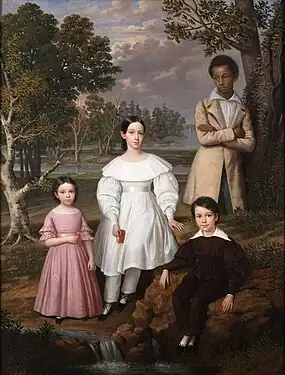| Bélizaire and the Frey Children | |
|---|---|
 | |
| Artist | Jacques Amans |
| Year | 1837 |
Bélizaire and the Frey Children is an 1837 group portrait painting attributed to the artist Jacques Amans that is a rare example of an enslaved person who is painted in a naturalistic manner.[1][2] It is in the collection of the Metropolitan Museum of Art, in New York.[1]
The painting shows the enslaved Afro-Creole teenager Bélizaire together with the three children of the New Orleans merchant and banker Frederick Frey.[3]
Frey's family purchased Bélizaire (b. 1822) and his mother, an enslaved woman named Sallie, when Bélizaire was six.[3][4] He was born in approximately 1822, so would have been about 15 years old when the portrait was painted. In 1856 Bélizaire was sold to be enslaved on the Evergreen Plantation, a sugar plantation in Louisiana, and researchers have been unable to determine what happened to him after 1860. The painting is the only known image that exists of one of the 400 persons who were enslaved at the Evergreen Plantation.[5][2]
Two of the Frey children in the painting died the same year it was painted,[3] and the other did not survive to adulthood.[5]
History of the painting
Around the turn of the 20th century, a member of the Frey family had the figure of Bélizaire painted out of the composition. When the family donated it to the New Orleans Museum of Art in 1972, the museum was informed that an enslaved person had been painted out, but no action was taken by the museum.[2]
The painting was deaccessioned from the museum's collection in 2005, and the acquirer removed the overpaint.[5]
The collector Jeremy K. Simien purchased the painting in 2021. Simien had it further restored by Craig Crawford, who removed remaining overpaint. (Crawford had earlier restored another New Orleans painting where lace had been painted over because a restorer had incorrectly determined that the subject would not have worn lace, because of her race.[6]) Simien also commissioned the historian Katy Morlas Shannon to research Bélizaire's identity and history, thus recovering his name and year of birth which was previously unrecorded in the museum documentation.[2]
Significance
The painting is the "first naturalistic portrait of a named Black subject set in a Southern landscape" in the American Wing of the Metropolitan Museum.[3] Its display is part of a national trend in museums and Southern historic sites to "address their history of slavery and how ... wealth was accumulated".[5]
References
- 1 2 "'His Name Was Bélizaire': Rare Portrait of Enslaved Child Arrives at the Met". The New York Times. 2023-08-14. ISSN 0362-4331. Retrieved 2023-08-16.
- 1 2 3 4 Cascone, Sarah (2023). "An 1837 Portrait of an Enslaved Child, Obscured by Overpainting for a Century, Has Been Restored and Acquired by the Met". ArtNet.
- 1 2 3 4 "The Metropolitan Museum of Art Acquires Important Painting Attributed to Jacques Amans". The Metropolitan Museum of Art. 2023-08-14. Retrieved 2023-08-16.
- ↑ "Resurfacing history: The Met to spotlight enslaved boy, Bélizaire, who had been concealed in family portrait". TheGrio. 2023-08-17. Retrieved 2023-09-04.
- 1 2 3 4 Clark, Maria (2021-10-26). "The boy who was almost erased from an 1837 painting now has an identity and a story". The Daily Advertiser. Retrieved 2023-08-17.
- ↑ Cleaver, Molly Reid (2022-06-17). "Identity theft: A rare painting damaged, a story half-told, and a reckoning about bias in art stewardship". The Historic New Orleans Collection. Retrieved 2023-08-18.